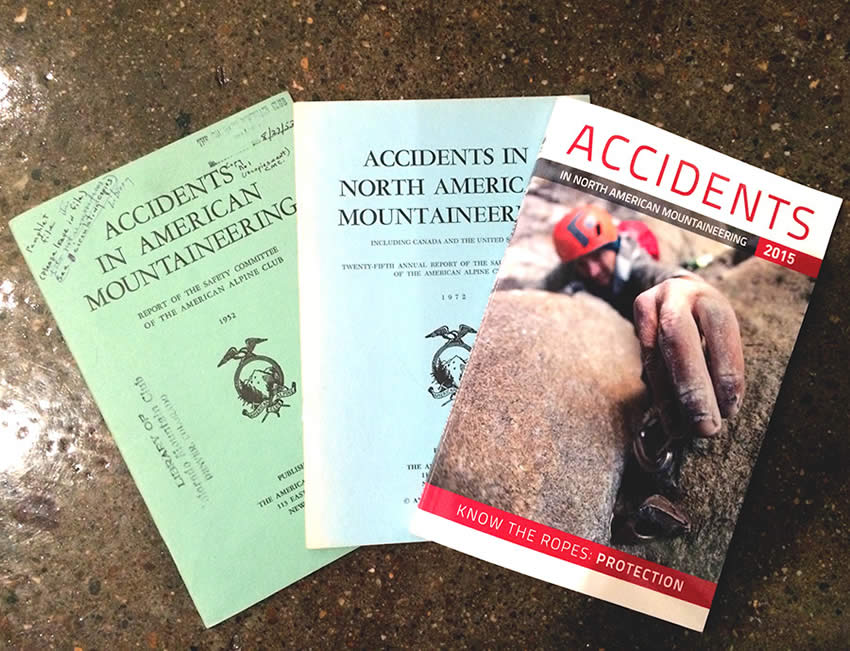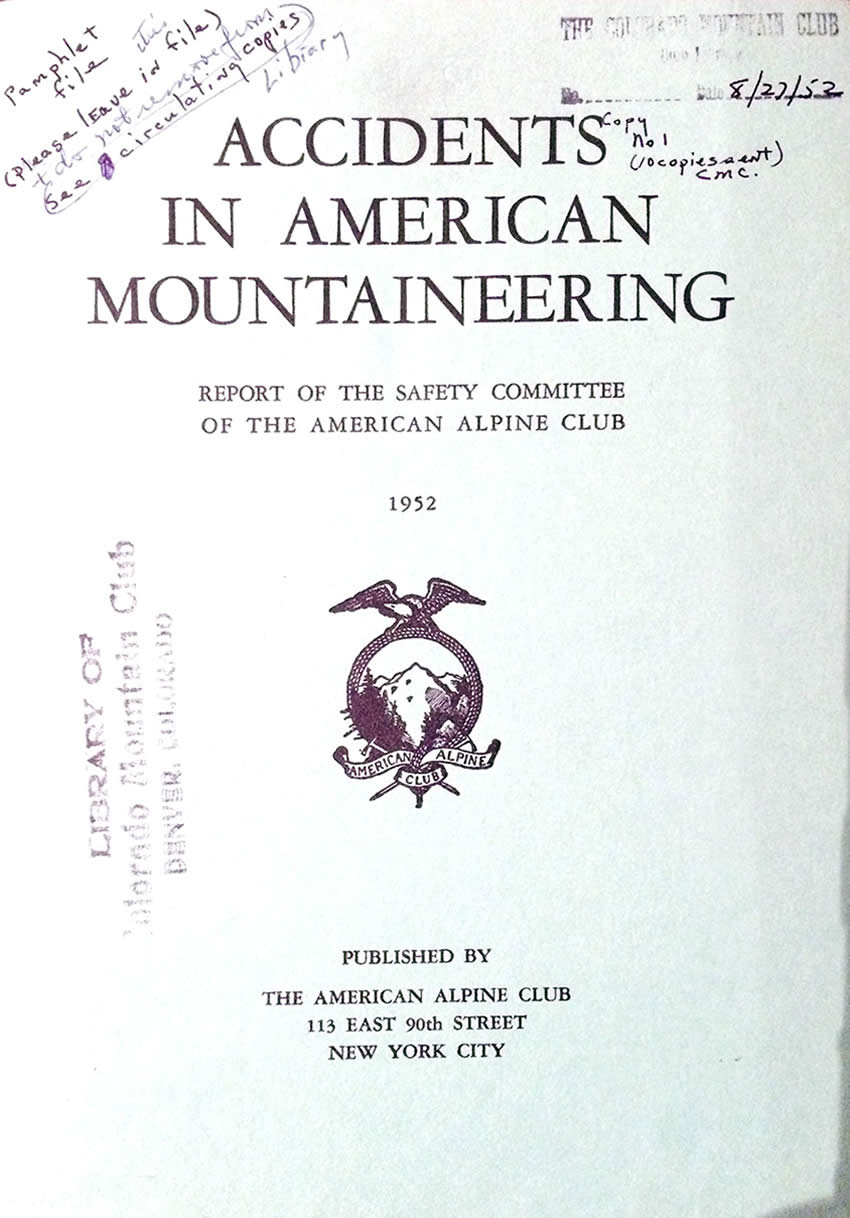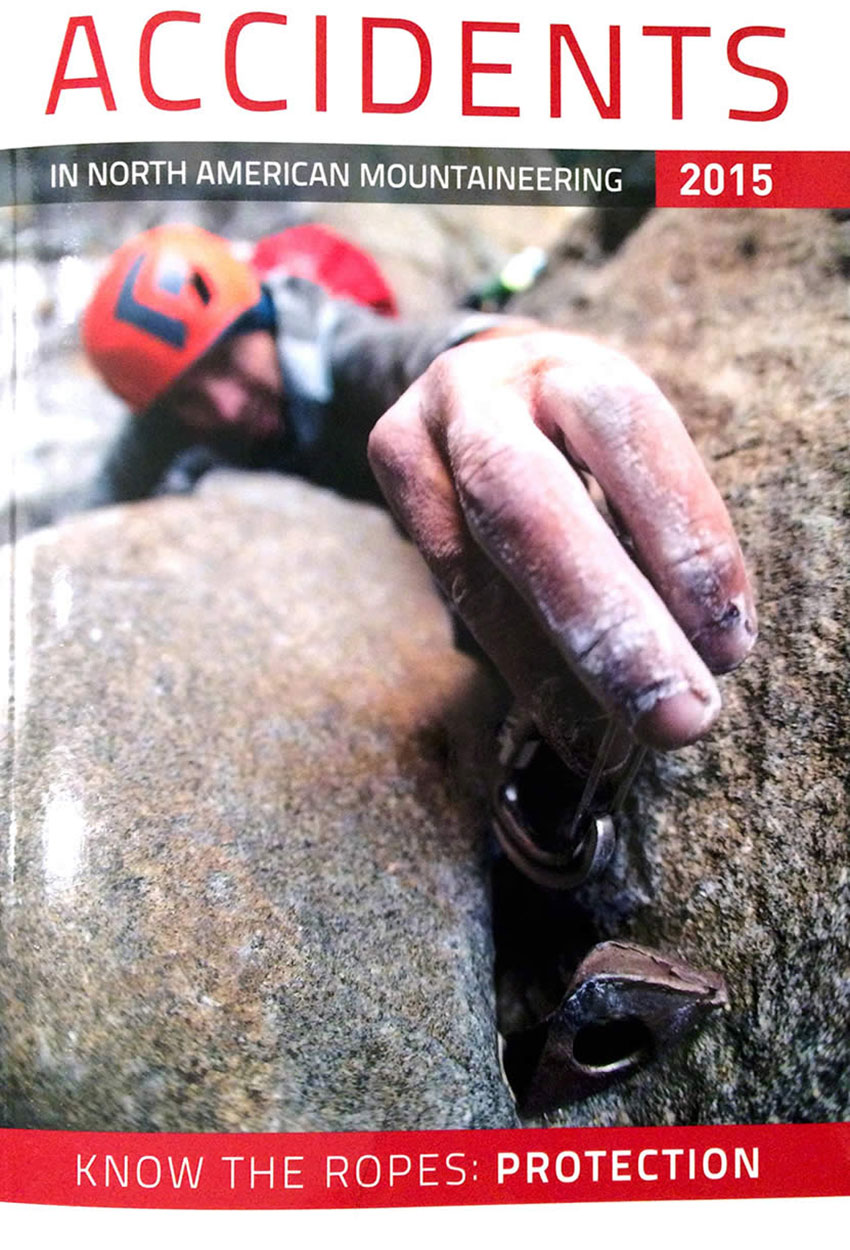Accidents in North American Mountaineering (ANAM) is published by the American Alpine Club and is one of the best resources available for climbers in all disciplines to learn from past mistakes, and to prevent future injuries and illnesses while in the mountains. Published annually since 1948, this book details many of the accidents and incidents that occur in the various realms of climbing and includes analysis and lessons learned for each.

No matter how careful we are and how much planning and preparation we undertake prior to climbing, accidents do and will happen. The accounts listed in ANAM, while unfortunate, are an avenue for climbers to help other climbers. All of the incidents are gathered by the Accidents' team of volunteers, working with the climbers and witnesses of each event, to focus in on the mistakes made and lessons that can be communicated to the to the greater climbing community. The book is organized by state in alphabetical order with Canadian accidents inserted after Wyoming.

Every member of the American Alpine Club receives a hard copy of the book, along with its companion text, American Alpine Journal (AAJ), that documents the most significant climbs of the past year. In addition to the print versions, these books are available to members digitally through the American Alpine Club website. For non-members, these books are available for purchase at climbing shops throughout the United States as well as other retailers and through the search function of the AAC website.
Accidents in North American Mountaineering is particularly useful for instructors of wilderness and climbing medicine. In our job as instructors, whether it be to medical practitioners or members of the general public, creating realistic scenarios is a must to prepare and test students on the topics taught during course. Accidents helps with this nicely by providing thousands of real-life events that can form a basis for a practice or testing scenario. I have found that students appreciate knowing that the scenario they just worked through actually occurred and they always want to know the real life outcome. Because there are so many available, instructors should never have to repeat a scenario from class to class. Not only is this helpful for students, but it is also great for instructors by keeping the classes fresh and unique.


To learn more about the history, development, and future of Accidents, we interviewed managing editor, Dougald MacDonald. In 2012, Dougald MacDonald became Executive Editor of the American Alpine Club's publication. As part of that transition, he recently took the helm of ANAM from longtime non-paid volunteer, John E. "Jed" Williamson, who guided the growth and development of the book for 40 years while serving as editor.
Dougald MacDonald is a longtime climbing journalist, and has served as Publisher and Editor-In-Chief of Rock & Ice and Editor-in-Chief of Climbing, while also founding Trail Runner magazine and working on multiple book projects to include, Long's Peak: The Story of Colorado's Favorite Fourteener. The interview below gives great insight to some of the exciting changes in ANAM and the benefits that climbers will receive from these additions.
Wilderness Medicine: Accidents in North American Mountaineering (ANAM) has been published continuously since 1948. Can you tell us a little of the history, development, and evolution of the book?
Dougald MacDonald: Accidents was created by the AAC's Safety Committee and specifically by Dr. Ben Ferris Jr., who designed the format that is still followed today in many ways. The AAC hoped to educate the growing numbers of climbers in postwar America and thus reduce the number of injuries and fatalities. Doctor Ferris was a specialist in public health and a very keen mountaineer, and he edited Accidents for more than two decades, from 1952 to 1973. Then Jed Williamson took over for the next four decades.
WM: John "Jed" Williamson voluntarily edited the book for 40 years, which is amazing. Can you tell us more about his efforts?
DM: Apart from his deep knowledge and incredible generosity (Jed was a volunteer the entire time he served as editor of Accidents), a couple of things strike me about his tenure. First, he was editor during a time of enormous growth in climbing's popularity and also a time of great changes in the nature of the sport. When he started as editor, pitons were still frequently used by rock climbers, Gore-Tex didn't exist, and the first climbing gym had yet to open. He had to adapt continuously to keep up with the changes. Jed also stressed that Accidents wasn't out to judge people who had gotten into trouble. The mission was always to educate. It's a fine line, because of course we point out lots of mistakes people make. But we definitely understand that climbers all make mistakes and accidents happen to the best of us, and hopefully that comes across in the pages of Accidents.
WM: ANAM does not merely describe accidents within the United States and Canada, but also provides analysis and assessment of each. How do you think this helps the climbing community?
DM: We hope climbers will come away from each edition with lots to think about—and hopefully put in practice. The analysis helps point them in the right direction.
Often the climbers themselves provide the best analysis. Climbers can be very analytical—and they can be very hard on themselves! When the climbers, park rangers, or SAR personnel don't provide any analysis, the editors step in and try to offer sound advice. We'll also sometimes ask an expert in a given field or technique to chime in. Sometimes accidents more or less speak for themselves. For example, if a solo rock climber falls off and dies, there's usually not much you can say in terms of "analysis." But most times there is something helpful we can say.
In the past, Accidents tried to document all technical climbing and mountaineering accidents, regardless of whether we could offer meaningful analysis. But now we're a little more selective, choosing the stories with the most educational value, including the analysis. We still try to include every technical climbing incident in our annual summaries (the tables in the back).
WM: In recent years there have been some additions to the accident reports, namely the "Know Your Ropes," "Essentials," and "Danger Zone" sections. Can you tell us more about each and any other planned changes or additions to Accidents? How were these developed?
DM: As I mentioned just now, our mission is education, and we felt we could play an important role in providing expert-based information that's purely educational and not tied to any one accident. Each "Know the Ropes" focuses on a technique or area of climbing that often leads to accidents (rappelling, for example). The "Essentials" pieces zero in on more specific topics, with concise tips, including medical advice. "Danger Zones" is a little different. In that story, we choose a popular area or climb, chart all the accidents that we've reported in that area for the past three or four decades, and analyze the most common causes of accidents and how they might be avoided. In 2016 we'll be focusing on the Grand Teton, most likely the Exum Ridge route.
The other big change in recent years is the addition of photographs and diagrams to the book. For most of Accidents' lifetime, it had no photos, but the 2015 edition has dozens of photos and illustrations. These are not only useful for explaining the intricacies of an accident or rescue, they also help the reader understand and visualize the scene. In 2016, we expect to go full-color for the first time in Accidents' history, which will help us do more complex diagrams. And of course it will look great!
WM: Accidents is now available online for members of the American Alpine Club (AAC), how has this assisted in the mission to get this information to climbers?
DM: Well, the world is going digital and AAC members are as well. We offer a PDF version of Accidents as a free download for AAC members, and we sell more digital copies through the AAC store and Kindle than we do printed copies. (That said, REI and other stores still sell plenty of the print books—print isn't dead, by a long shot.)
In 2013 we launched a website that allows anyone to search every report ever published in Accidents, all completely free. More than 4,500 articles in all. We still don't have the capability to do complex searches—for example, making it easy for users to find every rappelling accident that's happened at the Trapps in the Gunks. But that will come.
WM: The AAC is pursuing a new safety initiative within the club with particular focus on belaying and sport leading. How does ANAM fit into this new initiative?
DM: The AAC has made a big commitment to education, hiring a full-time education director. The initial focus is on creating consensus around a standard belaying technique that the club hopes will be adopted and taught by gyms and other climbing programs nationwide. Ideally, you'll be able to take a belay test at one gym and then show your belay card at other gyms around the country and climb without a belay test. That's one cool aspect that will help roll the program out, but the ultimate goal is to ensure that new climbers everywhere are using a standardized, easily teachable technique that really works.
Accidents will be contributing to the effort in this first year by covering belaying in our 2016 "Know the Ropes" article, including the techniques the club will be advocating.
WM: Many of our readers are both avid climbers and medical professionals. Do you have any suggestions for those who are interested to help ANAM?
DM: Accidents depends heavily on volunteers, including a corps of more than 15 regional editors. If people have strong climbing plus medical or SAR backgrounds, and they know their local climbing community well, we'd love to hear from them.
To learn more about the American Alpine Club, click here.
To learn more about Accidents in North American Mountaineering, or to purchase a copy, click here.
To report an accident using the Accidents' online reporting form, click here.
Posted on December 28, 2015